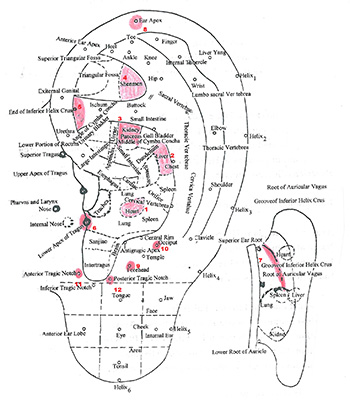Hypertension development is a long term and ongoing process. Left untreated, hypertension can impair the blood vessels, heart, brain, eyes, and kidneys for many years and without causing any symptoms. Many people are unaware of their blood pressure statuses until a life-threatening complication happened. According to the WHO 2013 statement, hypertension affects more than one in three adults (aged 25 and above) globally, which contributes to nearly 9.4 million deaths from cardiovascular disease every year.
Hypertension is both preventable and treatable, early detection is key, and with aggressive treatment and long term management as well.
Many complementary and alternative therapies are available for treating and preventing hypertension; auricular stimulation is one of the popular Chinese methods. It involves stimulating points on the ears that correspond to different organ systems of the body. In traditional Chinese medicine (TCM), the ears are not just for hearing; they are closely connected with the internal organs. TCM regards the ears as an important body part for clinical diagnosis and treatment, stimulating the points on them can achieve general or local effects. The way to stimulate the ear points can be needling, electricity, injection, blood-letting, pressing or moxa heating.
Auricular stimulation is indicated for a variety of conditions, and is relatively easy and simple to apply. For hypertension, the commonly selected points include: heart, liver, kidney, shen-men, sympathetic, adrenal gland, and lowering BP notch (see the graphic below). Here are some auricular stimulation protocols for hypertension:
- Needing method
Select points like adrenal gland, shen-men, lowering BP notch, & heart. Sterilize a ear and stimulate with 25mm or 13mm needles. Insert a needle into the cartilage and then twirl rapidly for 30 seconds, be careful not to penetrate through the ear, retain the needle for 20 to 30 minutes to enhance stimulation or to facilitate further manipulation. After finished, press the point with a cotton ball for a while, so as to prevent bleeding, then sterilized again. Stimulating on one side or both sides, do this every day or every two days, ten times as one course. If individuals cannot receive treatment on time due to work, intradermal needles are used instead, which can keep 2〜4 days, remind the individual to press the patches several times a day.
- Blood-letting method
This method is also known as "blood-letting acupuncture," because therapists often use a three-edged needle as tool. It is claimed that using appropriate techniques to release a few drops of blood can improve the localized qi (vital energy) and blood flows, which is beneficial to conditions like toxic heat accumulation, swelling, pain, blood stasis, hyperactive organs, restless mind and other head symptoms.
Before the operation, the tool and the selected area must be cleaned and sterilized. For hypertension, rub the back of the ear to make the veins congested, prick on a vein quickly and squeeze gently to release 4〜5 drops of blood, then press the punctured point with a clean swab to stop bleeding. This can be done every two days, prick on alternative side each time, 10 times as one course. Those who have bleeding problem, anemia, hypotension or pregnant women are NOT recommended.
- Seed pressing method
The seeds used for this method are vaccaria seed or white mustard seed, because they are tiny enough to place precisely on the ear point. The seed can act to relieve cramps, calm down, ease pain, and lower blood pressure. Based on the conditions, they are held in specific points of the ears with a small piece of adhesive tape, and may be left for days or even weeks. The individual should press them regularly during the time.
For hypertension, commonly stimulated points are ear apex, liver, lowering BP notch, forehead, occipital, eye 1, and eye 2 (see the graphic below). Before the operation, the tool and the selected area must be cleaned and sterilized. Select 3 to 4 points in one side, place the seed patches on them, and press for 30 seconds, so as to make the areas turn red, and feel heat and pain. Remind the individual to do that at home, that press for 4〜8 times daily and about 5 minutes each time. Change the patches o other side every three days, and measure the blood pressure for records. Ten times as one course.
- Magnetic bead pressing method
Select magnetic beads with a diameter of 1.5 to 2.0 mm and a magnetic intensity of 0.04 teslae (400G) around. Prepare 3 groups of points: (1) shen men and heart; (2) liver and kidney; (3) lowering BP notch. Place the beads on one group every week and on both sides. Before changing the magnetic patches, measure the blood pressure for records, if no improvement after nine weeks, stop it.
Auricular therapy is generally safe, however, if the external ears are inflamed or damaged, such as ulcers, sores, infections, and other skin problems, then it is not indicated. Moreover, auricular therapy especially by needling is not suitable for those who have bleeding tendency, anemia and pregnant women. Auricular therapy can achieve a better therapeutic result when combining with other treatment modalities.
 |
Commonly used ear points for hypertension
|
| |
1 |
Heart |
7 |
Lowering BP notch |
2 |
Liver |
8 |
Ear apex |
3 |
Kidney |
9 |
Forehead |
4 |
Shen-men |
10 |
Occipital |
5 |
Sympathetic |
11 |
Eye1 |
6 |
Adrenal gland |
12 |
Eye2 |
|
|